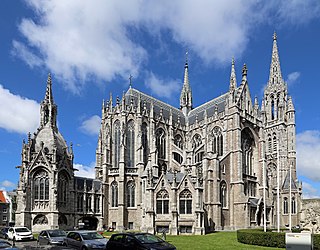This article needs additional citations for verification .(April 2016) |
| |||
|---|---|---|---|
The year 1916 in architecture involved some significant events.
This article needs additional citations for verification .(April 2016) |
| |||
|---|---|---|---|
The year 1916 in architecture involved some significant events.



Gothic Revival is an architectural movement that began in the late 1740s in England. Its momentum and interest grew in the early 19th century, when increasingly serious and learned admirers of neo-Gothic styles sought to revive medieval Gothic architecture, in contrast to the neoclassical styles prevalent at the time. Gothic Revival draws features from the original Gothic style, including decorative patterns, finials, lancet windows, and hood moulds. By the mid-19th century, it was established as the preeminent architectural style in the Western world.
This is a timeline of architecture, indexing the individual year in architecture pages. Notable events in architecture and related disciplines including structural engineering, landscape architecture, and city planning. One significant architectural achievement is listed for each year.
The year 1976 in architecture involved some significant architectural events and new buildings.
The year 1933 in architecture involved some significant architectural events and new buildings.
The year 1954 in architecture involved some significant events.
The year 1972 in architecture involved some significant architectural events and new buildings.
The year 1955 in architecture involved some significant architectural events and new buildings.
The year 1911 in architecture involved some significant architectural events and new buildings.
The year 1960 in architecture involved some significant architectural events and new buildings.
The year 1927 in architecture involved some significant architectural events and new buildings.
The year 1963 in architecture involved some significant architectural events and new buildings.
The year 1938 in architecture involved some significant events.
The year 1961 in architecture involved some significant architectural events and new buildings.
The year 1932 in architecture involved some significant events.
The year 1931 in architecture involved some significant events.

London's rich architectural heritage involves a wide variety of architectural styles from a variety of historical periods. London's distinctive architectural eclecticism stems from its long history, continual redevelopment, destruction caused by the Great Fire of London and The Blitz, as well as state recognition of private property rights which often prevented large scale state planning. This sets London apart from other great European capitals such as Paris and Rome which are more architecturally homogenous and adhere to a universal plan. London's eclectic architectural heritage ranges from the Romanesque central keep of The Tower of London, the great Gothic church of Westminster Abbey, the Palladian royal residence Queen's House, Christopher Wren's Baroque masterpiece St Paul's Cathedral, the High Victorian Gothic of The Palace of Westminster, the industrial Art Deco of Battersea Power Station, the post-war Modernism of The Barbican Estate and the Postmodern skyscraper 30 St Mary Axe 'The Gherkin'. Being the capital of the United Kingdom, London contains the most important buildings of the British state such as the Palace of Westminster: the centre of British democracy, Buckingham Palace: the official residence of the British Monarchy, 10 Downing Street: the official residence of the British Prime Minister and Westminster Abbey: the official church of Royal Family as well as the site of the majority of the coronations of English and British monarchs since 1066. London also contains numerous monuments such as the 17th-century Monument to the Great Fire of London, Marble Arch, Wellington Arch, the Albert Memorial and Royal Albert Hall in Kensington. Nelson's Column is an internationally recognised monument in Trafalgar Square, often regarded as the centre of London.

Charles Pierrepont Henry Gilbert, most often referred to as C. P. H. Gilbert, was an American architect of the late-19th and early-20th centuries best known for designing townhouses and mansions.
The year 2015 in architecture involved some significant architectural events and new buildings.
The year 2017 in architecture involved some significant architectural events and new buildings.
The year 2016 in architecture involved some significant architectural events and new buildings.